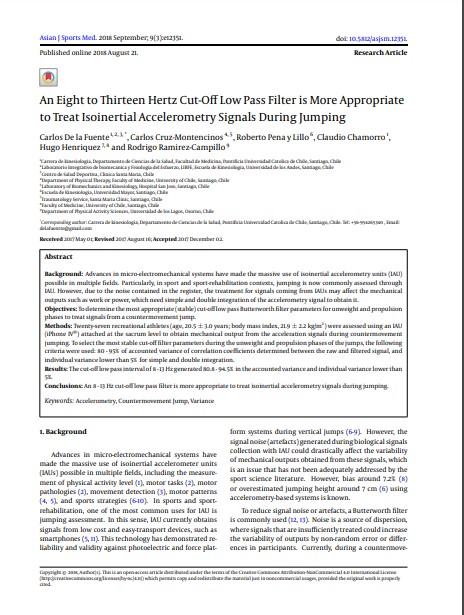An eight to thirteen hertz cut-off low pass filter is more appropriate to treat isoinertial accelerometry signals during jumping

Fecha
2018Autor
De la Fuente C., Cruz-Montencinos C., Chamorro C., Henriquez H., Ramirez-Campillo R.
Peña y Lillo, Roberto [Escuela de Kinesiologia, Universidad Mayor, Chile]
Ubicación geográfica
Notas
HERRAMIENTAS
Acceda a títulos restringidos
¿Cómo descargar?Resumen
Background: Advances in micro-electromechanical systems have made the massive use of isoinertial accelerometry units (IAU) possible in multiple fields. Particularly, in sport and sport-rehabilitation contexts, jumping is now commonly assessed through IAU. However, due to the noise contained in the register, the treatment for signals coming from IAUs may affect the mechanical outputs such as work or power, which need simple and double integration of the accelerometry signal to obtain it. Objectives: To determine the most appropriate (stable) cut-off low pass Butterworth filter parameters for unweight and propulsion phases to treat signals from a countermovement jump. Methods: Twenty-seven recreational athletes (age, 20.5 ± 3.0 years; body mass index, 21.9 ± 2.2 kg/m2) were assessed using an IAU (iPhone IV®) attached at the sacrum level to obtain mechanical output from the acceleration signals during countermovement jumping. To select the most stable cut-off filter parameters during the unweight and propulsion phases of the jumps, the following criteria were used: 80-95% of accounted variance of correlation coefficients determined between the raw and filtered signal, and individual variance lower than 5% for simple and double integration. Results: The cut-off low pass interval of 8-13 Hz generated 80.8-94.5% in the accounted variance and individual variance lower than 5%. Conclusions: An 8-13 Hz cut-off low pass filter is more appropriate to treat isoinertial accelerometry signals during jumping.
URI
http://asjsm.com/articles/12351.htmlhttps://doi.org/10.5812/asjsm.12351
https://sites.kowsarpub.com/asjsm/articles/12351.html
http://repositorio.umayor.cl/xmlui/handle/sibum/6957
Coleccion/es a la/s que pertenece:
Si usted es autor(a) de este documento y NO desea que su publicación tenga acceso público en este repositorio, por favor complete el formulario aquí.